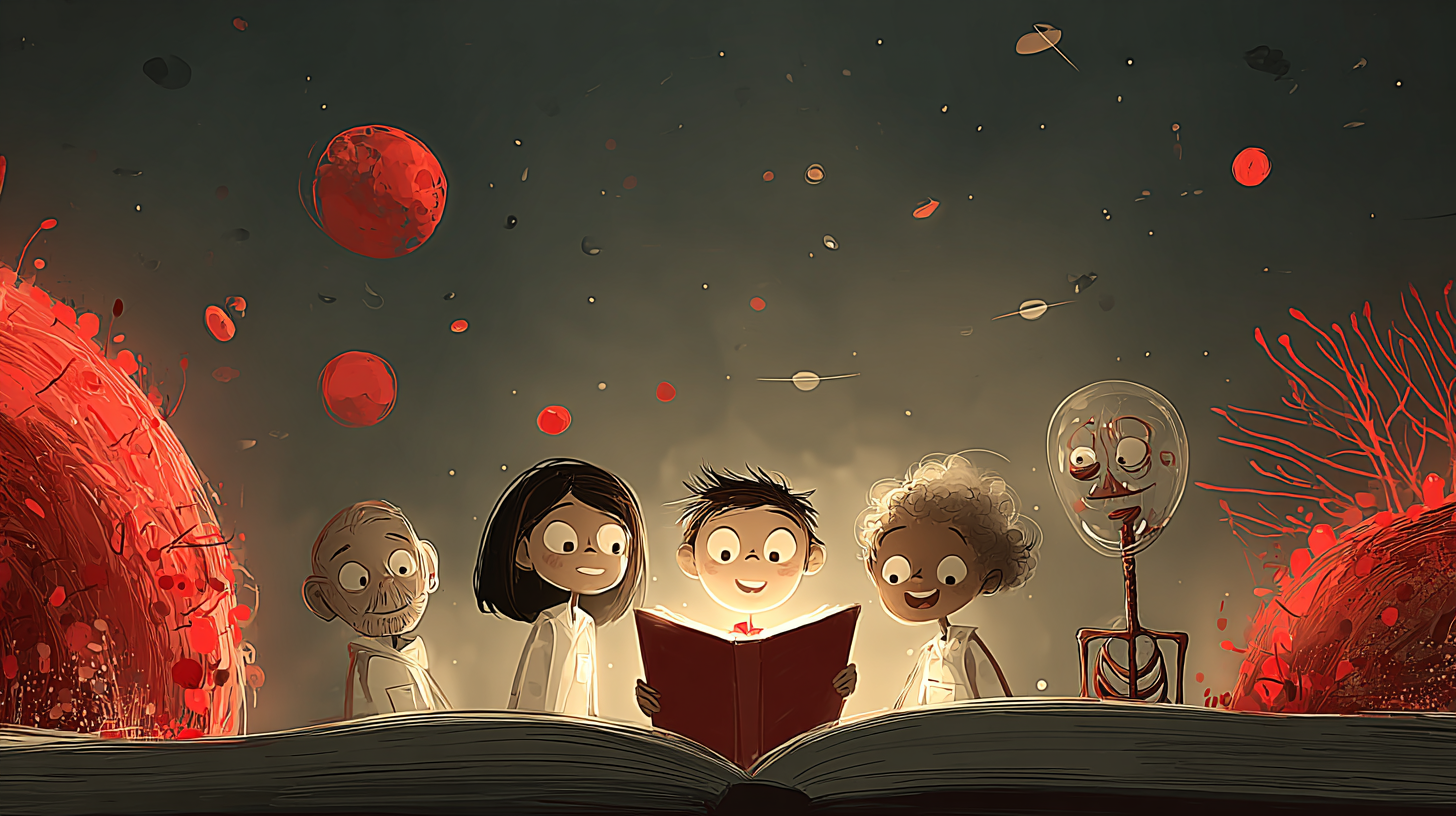“Illustration” means a picture in a book or an example to explain something.
「illustration」は本や雑誌にある絵や図のこと。また、何かを説明するための例のこともある。
以下は英単語 “illustration” に関するストーリー型学習コンテンツです。まずは大枠の意味を理解して最後の文章で確認しましょう。
主な意味(main meaning)
| 品詞 | 発音記号 (IPA) | 意味 | 例文 |
|---|---|---|---|
| 名詞 | /ˌɪl.əˈstreɪ.ʃən/ | 絵や図による説明、イラスト、例 | The book contains many colorful illustrations. |
語源(etymology)
ラテン語 illustrare(明るくする、説明する)から。
核イメージは「目で見てわかりやすくすること」。
類義語(synonyms)
| 類義語 | 意味 | 例文 |
|---|---|---|
| picture | 絵、写真 | She showed me a picture of her family. |
| drawing | 線で描いた絵 | He made a quick drawing of the house. |
| diagram | 図表 | The teacher used a diagram to explain the system. |
| figure | 図、挿絵 | The report included several figures. |
反義語(antonyms)
| 反義語 | 意味 | 例文 |
|---|---|---|
| text | 文章 | The text of the article is clear, but it has no pictures. |
| description | 言葉での説明 | She gave a description of the accident without any pictures. |
コロケーション(collocations)
| コロケーション | 例文 |
|---|---|
| provide an illustration | The teacher provided an illustration to make it clear. |
| vivid illustration | This story is a vivid illustration of friendship. |
| book illustration | The book illustration attracted young readers. |
| scientific illustration | The scientific illustration showed the parts of the cell. |
2項表現(binomials)
| 2項表現 | 例文 |
|---|---|
| black and white illustration | The magazine included a black and white illustration. |
| facts and illustrations | The lecture was full of facts and illustrations. |
英語ストーリー(english story)
The Power of an Illustration
Tom was a young graphic designer who had just started working at a publishing company. His job was to create illustrations for children’s books. At first, he thought it would be easy, but soon he discovered that making a good illustration was not only about drawing something beautiful. It was about communicating an idea clearly, sometimes even better than words.
One day, his boss, Ms. Green, gave him a new project. It was a science book for middle school students.
“Tom,” she said, “this book must contain many diagrams and figures. The text is fine, but without illustrations, the students will not understand difficult concepts. We need your help.”
Tom felt nervous. He had never worked on scientific illustrations before. He usually drew animals, houses, or people in a funny style. Now he had to create clear diagrams of the human body, the solar system, and chemical experiments.
At home, Tom studied the material carefully. He tried to understand the text, but some parts were too complicated. So he looked at other books for examples. He noticed that a vivid illustration often explained a difficult idea more clearly than a long description.
“This is the true power of illustration,” he thought. “It is not just decoration. It provides understanding.”
The next morning, Tom showed his first drawing to Ms. Green. It was a black and white illustration of the human heart.
“This is good,” she said, “but the students need more detail. Add labels to each part. Remember, a diagram must be both simple and informative.”
Tom nodded and worked again. He added arrows, colors, and labels. The second version looked much clearer.
“Excellent,” Ms. Green smiled. “Now it’s a real scientific illustration.”
While working on the solar system page, Tom made another discovery. At first, he just drew the planets. But then he realized that students might not understand the distances. So he added a scale and a figure showing how small Earth was compared to Jupiter.
“This is a vivid illustration of how big the universe is,” Ms. Green said when she saw it.
After a week of hard work, Tom finished all the illustrations. He provided diagrams, colorful pictures, and even small drawings to make the text more attractive. Finally, the book was ready to be published.
At the release party, one teacher said, “This book is wonderful. The text and illustrations work together. The facts and illustrations make science easy to understand.”
Another teacher added, “Without these illustrations, the book would just be a long text. The students would lose interest.”
Hearing this, Tom felt proud. He remembered the first day when he thought illustrations were only decoration. Now he understood that an illustration could be more powerful than words. It could open a student’s mind, give them new ideas, and make learning exciting.
From that day on, Tom decided to improve his skills not only as an artist but also as an educator. He wanted his illustrations to be more than pictures. He wanted them to be bridges between text and understanding.
和訳
イラストの力
トムは若いグラフィックデザイナーで、出版社に就職したばかりだった。彼の仕事は子ども向けの本に**illustrations(イラスト)**を描くことだった。最初は簡単だと思っていたが、すぐに気づいた。よいイラストを描くことは、美しい絵を描くだけではない。時には言葉以上にアイデアをはっきり伝えることができるのだ。
ある日、上司のグリーンさんが新しいプロジェクトを渡した。中学生向けの科学の本だった。
「トム、この本にはたくさんの**diagrams(図表)やfigures(挿絵・図)が必要よ。文章はよいけれど、イラストがなければ生徒たちは難しい概念を理解できないわ。あなたの力が必要なの。」
トムは緊張した。科学のillustrations(科学イラスト)**を描いたことがなかったからだ。普段は動物や家、人をユーモラスに描くことが多かった。しかし今回は人体、太陽系、化学実験の図を正しく描かなければならなかった。
家に帰ってトムは資料を注意深く読んだ。しかし、文章だけでは難しい部分も多かった。そこで、他の本を調べて例を見た。すると、**a vivid illustration(鮮やかなイラスト)が、長いdescription(説明)**よりもわかりやすく難しいアイデアを伝えていることに気づいた。
「これがイラストの本当の力なんだ」と彼は思った。「飾りではなく、理解を与えるものなんだ。」
翌朝、トムは最初の絵をグリーンさんに見せた。それは心臓の**a black and white illustration(白黒イラスト)**だった。
「悪くないけど、もっと詳しくしないとね。各部分にラベルをつけて。**a diagram(図表)**はシンプルでありながら、情報を伝えなければならないの。」
トムはうなずき、再び描き直した。矢印や色、ラベルを加えると、図はずっとわかりやすくなった。
「素晴らしいわ。これで本当の科学イラストになったわね。」
太陽系のページに取り組んでいたとき、トムは新しい発見をした。最初はただ惑星を並べて描いた。しかしそれだけでは距離感が伝わらないと気づいたのだ。そこで、縮尺を入れ、木星と地球の大きさの比較を示す**figure(図)を追加した。
「これは宇宙の大きさを示すa vivid illustration(鮮やかなイラスト)**ね」とグリーンさんは感心した。
1週間の努力の末、トムはすべてのイラストを完成させた。図表、カラフルな絵、そして小さな挿絵まで用意して、文章をより魅力的にした。ついに本は出版されることになった。
出版記念の会で、ある先生が言った。
「この本は素晴らしい。文章と**illustrations(イラスト)**がよくかみ合っている。**facts and illustrations(事実とイラスト)が科学をわかりやすくしているね。」
別の先生も加えた。
「もしイラストがなかったら、この本はただの長いtext(文章)**になってしまう。生徒たちはすぐに飽きてしまうだろう。」
それを聞いて、トムは誇りを感じた。イラストは飾りにすぎないと思っていた最初の日を思い出した。しかし今は理解していた。イラストは時に言葉以上の力を持ち、生徒の心を開き、新しいアイデアを与え、学びを楽しくできるのだ。
その日からトムは、単なるアーティストではなく教育者としての力も高めようと決意した。彼のイラストはただの絵ではなく、文章と理解をつなぐ「橋」になることを望んだのだった。
Q&A
Q: 「illustration」と「picture」はどう違いますか?
A: 「picture」は一般的な絵や写真全体を指しますが、「illustration」は説明や理解を助けるために描かれた絵を指します。つまり「illustration」は機能的な要素が強いのに対し、「picture」はより広い意味で使われます。
Q: 「illustration」と「drawing」はどう違いますか?
A: 「drawing」は鉛筆やペンで描いた「線画」という意味が中心です。一方、「illustration」は本や雑誌などで文章を補足する絵全般を意味し、色やスタイルに関係なく「説明のための絵」である点が特徴です。
Q: 「illustration」と「diagram」はどう違いますか?
A: 「diagram」は情報を整理した「図表」や「模式図」です。文字や線を多用し、データや仕組みをシンプルに表すのが目的です。これに対して「illustration」は絵としての要素が強く、視覚的に理解しやすくする役割があります。
Q: 「illustration」と「figure」はどう違いますか?
A: 「figure」は報告書や本に出てくる図・挿絵・グラフなどの総称です。科学論文やレポートでは「Figure 1」のように番号で呼ばれることが多いです。「illustration」はその中の「説明用の絵」にあたります。
Q: 「illustration」と「text」の違いは?
A: 「text」は文字や文章そのもので、読み取って理解する情報です。「illustration」は絵で伝える情報なので、表現手段が正反対になります。
Q: 「illustration」と「description」の違いは?
A: 「description」は言葉で物事を説明することです。一方「illustration」は絵や図で説明するものです。どちらも「説明」ですが、手段が異なります。
Q: 「illustration」と「provide an illustration」の違いは?
A: 「illustration」は名詞で「イラスト」「例」を意味します。「provide an illustration」は「イラストを示す」または「例を挙げる」という動作を表します。
Q: 「illustration」と「vivid illustration」の違いは?
A: 「vivid illustration」は「生き生きとした例」や「鮮やかでわかりやすいイラスト」を意味します。単なる「illustration」よりも「強く印象づける」ニュアンスが加わります。
Q: 「illustration」と「scientific illustration」の違いは?
A: 「scientific illustration」は科学的な説明のための特別なイラストです。美しさよりも正確さと情報の明確さが重視されます。
Q: 「illustration」と「black and white illustration」の違いは?
A: 「black and white illustration」は白黒で描かれたイラストを意味します。色がないだけで、基本的には「illustration」の一種です。
Q: 「illustration」と「facts and illustrations」の違いは?
A: 「facts and illustrations」という表現は「事実とイラスト(例)」を一緒に使って説明する、という意味です。単独の「illustration」よりも「補強として事実と並べて使う」というニュアンスがあります。



コメント